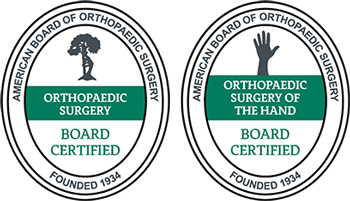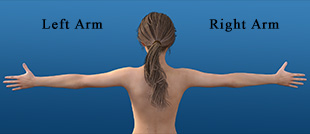Wrist Sprain or Break? How to Tell and What to Do

We’ve all been there: A trip, slip, or missed step sends us tumbling to the ground, bracing ourselves with our hands and bent wrists. This sort of fall often causes wrist pain – but is it a sprain or a fracture?
An incorrect diagnosis (or no diagnosis at all) could extend recovery time significantly or lead to surgery that could have been avoided with proper treatment. In the long term, an improperly treated wrist injury could cause chronic pain, stiffness, and arthritis, making the correct diagnosis and comprehensive care all the more important.
Contents
What’s the Difference Between a Wrist Sprain or Break?
With many of the same causes and symptoms, sprains and fractures can be hard to differentiate. Anatomically, a fracture is the breaking of a bone, while a sprain is an over-stretching or tearing of a ligament within the wrist. Swelling in the wrist, bruising, pain when moving, and weakness are all present in both injuries. Only a medical provider can make a definitive diagnosis and set the proper treatment path, but there are several distinguishing symptoms between the two:
- Numbness and tingling. With a fracture, there is a greater chance of damage to nerves and blood vessels, potentially leading to numbness or tingling in the hands and fingers. In these cases, it is advisable to immediately seek medical attention, as a loss of blood flow to the joint can have significant, long-term consequences and may necessitate surgery.
- Pops and tears vs. cracks and crunches. Wrist sprains are often signaled by a “popping” noise at the time of the incident – characteristic of a torn ligament. Fractures, on the other hand, are often accompanied by a crack, and movement after the injury may make a small grinding or crunching sound which is not present with sprains.
- Range of motion. A fracture, even if unnoticeable to the naked eye, may force the bones of the wrist out of line, significantly limiting the joint’s range of motion. A wrist sprain, while painful, may not limit the range of motion.
- Any obvious deformity or unnatural bend in the wrist. Generally, these symptoms signal breaks that are more severe and require immediate medical attention. The same goes for any break in which the bone has punctured the skin. However, given the small size of the bones in the wrist, many fractures are not overtly visible. In fact, of the eight small bones which make up the wrist itself – also known as carpals – the most commonly fractured is the scaphoid, which rarely causes any noticeable wrist crookedness. To this end, these fractures are often misdiagnosed as wrist sprains.
- Different types of pain. Generally, both fractures and sprains are associated with sharp pain during movement and dull pain when stable. However, fracture pain when immobilized is sometimes described as achy, while sprains may have a more throbbing pain. Importantly, while the type of pain experienced in bones vs. muscles and joints can somewhat differentiate the two injuries, both have a wide variation in pain levels. One is not necessarily always more painful than the other; both are dependent on the extent of the injury.
- Milder wrist sprains can respond particularly well to rest, ice, and OTC pain medications such as Tylenol or Aleve. In comparison, most fractures need significant time to heal, and may need to be set back in place. To this end, a couple of days of rest likely won’t significantly reduce the pain of a wrist fracture.
Notably, the two injuries are not mutually exclusive – one can have both a break and a strain, and the combination is not uncommon. For an accurate and complete diagnosis, a medical provider must be seen.
When should I see a doctor?
If you are in excruciating pain, suspect a fracture, have significant numbness and tingling, or the wrist is clearly deformed, seek medical attention immediately at an urgent care or emergency department.
However, if pain and swelling are milder – characteristic of a low-grade wrist sprain – the American Academy of Orthopedic Surgeons recommends trying rest, ice, compression, elevation, and pain medication. If symptoms persist for more than two days, a doctor should be seen.
In general, the complexity and delicacy of the wrist make home treatment without the aid of a medical professional unadvisable. Particularly in the case of a wrist fracture – where blood flow to the joint can be cut off, causing bones to die and necessitating an implant – medical attention is required.
Diagnosis and Treatment: How Dr. Knight Can Help
A physical examination from the doctor, combined with a detailed medical history, may be enough to diagnose the injury; however, an x-ray is deemed the gold standard to identify a fracture. That said, some smaller breaks – e.g., a scaphoid fracture – may take up to two weeks to appear on an x-ray, complicating diagnosis in the emergency room or urgent care immediately after the injury. In these cases, an MRI or CT scan, which elucidate damage to the soft tissues of the joint, can improve diagnosis.
Treatment for wrist sprains and fractures may be non-surgical or surgical. Immobilization with a splint or cast is common for milder fractures, while various surgical techniques – such as the use of pins to fix fractured bone segments together – may be needed for complex or severe breaks.
Wrist sprains seldom require surgery, but they can be tricky and often cause much more damage than is apparent. The use of ice, compression, and splinting can go a long way for milder sprains, but a full tear of a ligament will require surgical repair.
It is important for both injuries to be treated as soon and as comprehensively as possible to avoid any lasting, chronic pain or malformation of the joint. Dr. Knight is one of the premier national wrist specialists with extensive experience in non-surgical and surgical treatment of the wrist. For a deep dive into the treatments offered by Dr. Knight for each injury, see the wrist sprain, wrist fracture, and scaphoid fracture pages.
Citations
- Leversedge, F. J. (April 2018). Wrist Sprains. Retrieved from https://orthoinfo.aaos.org/en/diseases–conditions/wrist-sprains/
- Wrist Sprains (n.d.). Retrieved from http://www.assh.org/handcare/hand-arm-injuries/wrist-sprains
- Wrist Fractures (n.d.). Retrieved from https://handcare.assh.org/Anatomy/Details-Page/articleId/27933
- Broken wrist (December 2018). Retrieved from https://www.mayoclinic.org/diseases-conditions/broken-wrist/symptoms-causes/syc-20353169
- Jones, B. and Rozental, T. (March 2016). Scaphoid Fracture of the Wrist. Retrieved from https://orthoinfo.aaos.org/en/diseases–conditions/scaphoid-fracture-of-the-wrist/

























